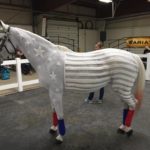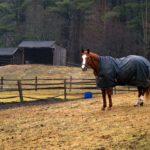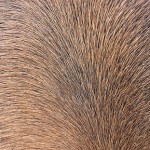There’s a common myth that only unhealthy horses, or horses who aren’t regularly attended to, are susceptible to lice infestation (otherwise known as pediculosis). If you haven’t found out the hard way that this simply isn’t true, there’s also a research study that proves that healthy horses can become infested with lice. Why are we bringing up this topic now? Because although your horse can become infested with lice at any time of the year, infestations are more common in the winter and spring months (when horses’ coats are thicker and longer). In addition, not only is the sharing of blankets a potential source of lice infestation, but blankets also hide the early warning signs of a horse ridden with lice. In the colder months we tend to bath our horses less (normally an easy way to physically remove lice) and keep them indoors more. And guess where lice tends to occur? In crowded, indoor, confined settings!
There are two types of lice found in horses: Sucking lice and Chewing lice. Sucking lice feed on the horse’s blood by implanting their mouths into the roots of a horse’s hairs. They prefer to live in the tail, under the forelock, and under the mane; Areas where the horse has longer and courser hair. Chewing lice feed on the horse’s dander and crawl around on a horse’s skin. They live on the head, neck, mane, flanks, and base of the tail, where the hair is finer.
Because lice make horses itchy, one obvious sign of pediculosis is biting and scratching at the skin. If you see any patches of hair loss on your horse’s face, mane, or chest, it’s possible your horse has rubbed it away due to severe itching. Some signs aren’t so obvious though. If your horse’s hair becomes ruffled, matted, and looks really unkempt, it could also be the result of lice. Other signs of horse lice infestation such as irritability, anxiousness, depression, and lethargy can be overlooked and wrongly attributed to “the winter blues” (which are brought on by being stabled/indoors too much in the winter).
Shorter hair not only makes it easier to detect lice, but since lice like to live in long, thick hair, it also deters them. So it’s ideal to keep your horse’s hair clipped, but in the winter that’s not always practical or ideal. That’s why it’s important to check your horse’s hair more often and be more vigilant in the winter months. Bring your horse indoors to a brightly lit area every couple of days and inspect their hair in key areas while you’re grooming them. Use a metal curry comb to work your way through their coat. If you suspect lice, but can’t actually see any, try using a spot light (the bulb gives off heat) or a hair dryer to bring the lice out. In addition, while most horse owners typically wash their horse blankets and sheets once or twice a year, it’s a good idea to wash them more often during the winter months. You can find affordable spare horse turnout blankets on sale
now that we’re into the winter months. When you’re washing your blankets be mindful of chemicals and detergents that will reduce the effectiveness of waterproofing treatments. An alternative and effective way to kill microorganisms on/in your blankets is to use very hot water for washing and very high heat for drying.
We’ll cover other year-round preventive measures and ways to deal with lice in a later post, but for now, we just wanted to give you a winter warning and remind you to keep a watchful eye out for those nasty, blood sucking, dandruff eating creatures! Poor horses… they can’t even use their legs to scratch!








